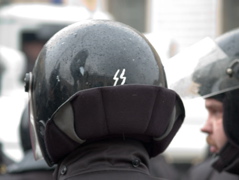It is not possible for a member of the Russian special police to have drawn the SS symbol on his helmet. That’s by definition impossible, or so Mikhail Grishankov, Vice-president of the Security Commission of the Russian State Duma, seems to think. When the Russian edition of Esquire Magazine recently published a photo of a demonstration which clearly showed just such a helmet, Grishankov exploded. He claimed that the editors themselves must have drawn the SS symbol on the picture, thus breaking the law and above all damaging the reputation of Russia. But what’s the truth of the matter?
On the 3rd of March, a Russian opposition group organized the largest anti-government rally in years. This is how the news was reported on Swedish radio at 16:45 that afternoon:
When Russian elite troops from OMON beat up and detain a few thousand demonstrators in Saint Petersburg, Russian television shows only pictures of riots in Copenhagen. Not a word is said about the opposition’s march, which by Russian standards is a big one, in the second largest city in the country. A number of the demonstrators, which represent the Other Russia movement, were arrested. According to the police thirty were arrested, but the organizers say it was several hundred.
That same evening, the main news broadcast from Russian State Television, Vremya, finally mentioned the events in Saint Petersburg. The report in Vremya about the large demonstration in Saint Petersburg began at 19:08 Swedish time, after a long item about the unrest in Copenhagen. The report about Saint Petersburg lasted just over a a minute – only half of the time devoted to Copenhagen, despite (or because of) the fact that it was about the largest anti-government demonstration in Russia in recent times. The only person who was allowed speak about it on television was Valentina Matvienko, Governor of Saint Petersburg. There was no representative of the demonstrators, of course. The coverage was introduced by a comment from the news anchor, speaking for himself:
Today there were also disturbances in the center of Saint Petersburg, but while in Denmark the cause was that young people were being forcibly thrown out of their house, in the northern capital the troubles were provoked by hooligans.
This is how the proper approach was decided: in foreign countries there may be good reason for demonstrations, but in these parts its just hooliganism. Ever since, Russian authorities have been trying to makelife hard for the ”hooligans” that try to demonstrate here and there across the country. Opposition activists are taken into preventive custody, called up at a moment’s notice for military service, or prevented from traveling freely around the country. The most notable incident happened on the 18th of May. Several leaders of the opposition were detained at a Moscow airport when they arrived to travel to Samara to take part in a demonstration linked to the Russia-EU summit. Their tickets ”didn’t work” in the computer system and the police confiscated their passports. They weren’t ”arrested”, but they also weren’t allowed to leave the airport. After the flight to Samara took off, the police returned their passports.
And after all this, Mikhail Grishankov, Vice-president of the Security Commission of the Russian State Duma, concludes that the reputation of Russia abroad has been damaged. What could be the cause? The brutal conduct of the police? Authorities that ignore Russia’s own laws, break up peaceful demonstrations, arrest opposition leaders and at the same time assert that they have not been arrested? Or perhaps Russia’s state-directed media, which prefer to report about demonstrations in Copenhagen?
Of course not. What has really damaged the reputation of Russia is the Russian edition of Esquire magazine, which published photos of a Russian policeman with an SS symbol on his helmet. ”Careful analysis gives reason to believe that the picture with the SS symbol was fabricated through photomontage – in other words that the published picture was false,” they clarified. The picture not only undermines the reputation of Russia, but in addition it’s publication is illegal, because the law against extremism forbids the distribution of symbols of extremist organizations, he argues.
To show that the picture is genuine, the photographer Oleg Kabatov has released the original picture file in his blog. He has also made a link to a photo in the blog of another photographer. In that photo, the same helmet with the symbol of the SS is clearly visible. But all of this, of course, is irrelevant if one has already decided that the problem is the photograph, not the helmet or (terrible thought) the head inside in the helmet.
The TV channel NTV which, under the ownership of the gigantic gas company Gazprom, has become extremely obedient, just recently showed a ”research documentary” with the title Кто заказывает хаос? (”Who’s ordering chaos?”) In the film, Mikhail Grishankov again asserts the picture is false:
When you think that we’re in fact talking about a US magazine, published in Russia, you begin to wonder: what is their goal in doing this?
Obviously, all of this is a plot by the United States, and obviously the international reputation of Russia is damaged by a picture in Esquire, not by that policeman who drew the SS symbol on his helmet, or the actions of the Russian authorities generally.
There is an old Russian proverb about this:
Не пеняй на зеркало, коль рожа крива.
(Don’t blame the mirror, if there’s something wrong with your face).
Text: Kalle Kniivilä
Translation from Esperanto: Steven Brewer and Brian Moon

3 svar på ”Is something wrong with the mirror?”
[…] Zürich (jvo) Today the eight article for the ”Blog-Carnival Russian Media” were published: Is somethin wrong with the mirror? from swedish/finnish diVERse-Blog. Some days ago published in Swedish language: ”Är det […]
[…] Besides the Russophile attack on this blogger, here is an interesting comment of another element of the New Russia. Posted in media | No Comments […]
[…] “Is something wrong with the mirror?” […]